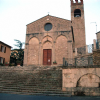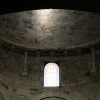- Home
- AboutBeen to the project TRADERE
- SearchSimple and advanced search
- People
- Photographers
the authors of the photographs in the Archive - Artists
who have used travertine Rapolano - Persons
identified in the photographs of the Archive - Interviews
list of persons interviewed
- Photographers
- Series
- Browse
- Partners
Bodies owners the Archive, funding agencies, companies that have contributed, individuals who have in various ways contributed to the project
Archivio TRADERE
to safeguard the know-how of Travertine stone workers
|
Photos from the series: Collegiata di Sant'Agata
The primitive design of the apse and the transept dates back to Byzantine times. It sees that this was a very ancient pagan temple dedicated to Venus, or more reliably, to the goddess Cupra. Testimony is given by the Romanesque architectural structures, but also by a multiplicity of friezes and decorations which appear on the jambs of the old doors and on the drum of the cupola. Having an unusual octagonal shape on the outside, on the inside the cupola is imposed on four pilasters and is connected to a square design by means of funnel-shaped sprandels. The coping, including the lantern, is definitely later. By carefully observing the diversity of the colour of the stones used in the building of the spherical vault, it is easy to presume that, before its imposition, the cupola had a roof with eight triangular inclined roof surfaces as covering for the lantern.
The church was built, therefore, much earlier than the year one thousand: i.e. when the baptismal font still belonged to the ancient parish church of Sant'Ippolito. The new parish church, to which the baptistery and the relative rights were transferred, was first named for the apostle St Andrew: this is inferred from the writings on parchment pertainting to the trial of October 27, 1393 in settlement of the dispute between the parish priest of Sant'Agata and the Commune of Asciano regarding the claim of the patronage of the church. The historians Orlandini and Burali gave value to it in the chronology of the Bishops of Arezzo, as does Pecci in that of Sienese Bishops (they cite a “baptisterium Sancti Andreae” as existing in the parish of Asciano). Since there are no traces of other churches dedicated to Sant'Andrea (St. Andrew) in the territory of Asciano, it can be argued that this is the same temple.
In 1040, this church of Asciano was named “plebs Santae Agathae” within the context of a testamentary deed of Count Ranieri della Scialenga, the son of Count Gualfredo, in regard to the location of a vineyard and a rustic property in the territory of the parish church: “infra plebem S. Agathae” and near the “Cupra brook”. In 1045, the bishop of Arezzo, Immone, assigned the parish church of Sant'Agata in administration to the chapter of his cattedral. Thus, the ancient parish church of Sant'Ippolito, located in the middle of the countryside, became a church that was subordinate to the new “ecclesia mater” of Sant'Agata, located in the fortified village of Asciano. The reason for the change in the name of the saint, from Sant'Andrea to Sant'Agata would not been known had it not been for the intervention of the tradition – that claimed that, in imploring the intercession of the Saint from Catania, a priest had thrown a reliquary of Sant'Agata into the center of a fire that was furiously threatening to destroy Asciano. According to what has been handed down, the fire was immediately extinguished. A Bull of 1178 of Pope Alexander III listed the churches of the ancient parish of Sant'Agata. The list gave the names of twenty-seven subordinate churches, including that of Sant'Ippolito, within the radius of an extremely vast territory.
During the 13th century, the battlemented bell tower was erected alongside the primitive church, both as a watch tower for the castle of Asciano, in the vicinity of the Porta Maggiore that was also called Porta Sant'Agata (an inscription in stone of 1281, at the time of Bishop Diffelio of Arezzo, bears witness to this), and also as an actual bell tower (the bell which was first installed in the new bell tower dedicated to Sant'Agata bears the date of 1280).
During the 14th century, the single nave was built, in Gothic Style. Thanks to the technique of the masters from Como, a branch of the ancient design in the form of Greek cross was lengthened to the west. The magnificent façade framed with soaring arches, is silhouetted against a wide staircase with three orders of white travertine.
1393 was a year of the aforementioned controversy regarding the patron saint of the church.
In 1437, with a decree of the diocesan Bishop, it was ordered that “all legacies to the parish church of Sant'Agata” had to “be converted into the needs of the Church”.
The parish church of Sant'Agata was erected as a collegiate church in 1542, year IX of the pontificate of Paul III, first with four and then with seven canons and two dignitaries (provostship and archpriestship). The last parish priest and first rector was Jacomo Billò, who died in 1544. The fifth canonry, under the name of Sant'Antonio Abbot, was ordered bi Monsignor Ricci, Bishop of Arezzo, with his Bull of 11th July 1630; the sixth was in the following century.
The rural vicariate extended from year to year until, in the 17th century, it reached the number of 30 parishes included in the territories of three communes: almost the territory of a diocese. In 1887, twenty-two parishes still formed the vicariate of Asciano.
In the years 1878-1885, the church was restored to the design by the architect Partini. The seven baroque altars were removed, and the high altar was built. The church was plastered and decorated with horizontal red and white stripes on the walls and with friezes and stars under the arches and vaults. In 1885, the Italian government entered the name of “this Parish Church of Sant'Agata, formerly the collegiate church, among the monumental churches of the Kingdom, in the third class”. In 1954, the church was closed to worship for new restorations. The plasterings were removed from the walls and from the vaults of the transept and the cupola, the high altar was lowered, and the orchestra was taken out. Today, it represents its ancient face, vivid in grey stone, bare and surprising.
The abundant wealth of its paintings by well-known artists was gathered, for safety reasons, in the adjacent Museum of Sacred Art, institued in 1952 (formerly the Oratory of Santa Croce). In the church remain the large fresco of the Madonna Enthroned that is attributed to Girolamo Sodoma, the 14 Stations of the Via Crucis made of polychrome terracotta of quite good workmanship (the work a local workshop), several 17th-century paintings by Sienese masters, and also the baptismal font in perfect Romanesque style from the very old parish church of Sant'Ippolito, carved in a block of monolithic travertine. In it baptism by immersion was originally administrered. In an urn placed on the left wall of the nave are preserved the mortal remains of the “handmaid of God”, Teresa Francini Naldi, from Asciano. A 15th century wooden crucifix, a very precious work of art, dominates the back of the central apse: a simulacrum of piety and veneration.
In 1975, together with all churches in the Commune of Asciano, the parish church of Sant'Agata passed from the Diocese of Arezzo to the Diocese of Siena.
In 1991, the former collegiate church was appointed with the title and dignity of a basilica by the Holy See.
The church of Sant'Agata is a real pearl, a source of pride not only for the town of Asciano, but also for a good part of Sienese territory. On the left side of the church, in a special little chapel, there is the new baptismal font, carved in onyx: the work of the sculptor Ugo Baglioni (1946). Its base is encircled by bronze statues of the three Theological Virtues. San Giovanni Battista towers above it. The fired-brick floor, inaugurated on 24th December 1995, is also new. (http://www.palazzomonaci.it/eng/asciano/22/basilica_di_sant_agata-id-110.html) |
|
|

























